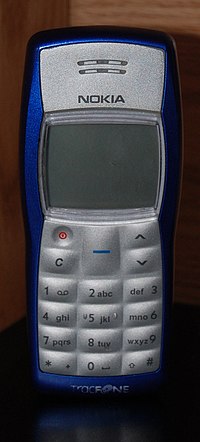 | |
| Manufacturer | Nokia |
|---|---|
| Series | Series 30 (DCT-4) |
| Predecessor | Nokia 3310 Nokia 3210 Nokia 5110 |
| Successor | Nokia 1110 (1100) Nokia 1110i (1101) Nokia 1112 (1108) |
| Related | Nokia 2100 Nokia 2300 |
| Form factor | Candybar |
| Dimensions | 106 × 46 × 20 mm, 79 cc |
| Weight | 86 g |
| Memory | Dynamic phonebook memory:
|
| Battery | Nokia BL-5C
|
| Charging | Nokia ACP-7E or Nokia ACP-7U 3.7V power adapter |
| Display | Monochrome, 96 × 65 px |
| Data inputs | Keypad |
| Model | RH-18 (1100) RH-36 (1100b, 1108b) |
| Made in | Finland: Espoo Germany: Bochum |
| Other | Built-in flashlight Clock alarm Stopwatch Calculator Composer Screensaver Snake II and Space Impact+ built-in games |
The Nokia 1100 (and closely related variants, the Nokia 1101 and the Nokia 1108) is a basic GSM mobile phone produced by Nokia. Over 250 million 1100s have been sold since its launch in late 2003,[1] making it the world's best selling phone handset[2] and the best selling consumer electronics device in the world at the time.[3] The model was announced on 27 August 2003[4] and was discontinued in September 2009.[5]
The 1100 achieved its popularity despite being made during a time when more modern and advanced devices were available in the market. It was targeted towards developing countries and users who do not require advanced features beyond making calls and SMS text messages, alarm clock, reminders, etc.[6] The Nokia 1100 was the company's cheapest mobile phone when it was released to the market,[7] making it ideal for the developing world. Its feature set is similar to the previous 5110/3210/3310 models that were among the most popular mobile phones in the world during their time, before handsets developed several new features such as cameras, polyphonic ringtones and colour screens.
The Nokia 1100 case was designed at Nokia Design Center in California,[8] and patented for the US by the Bulgarian-American designer Dimitre Mehandjiysky.[9] The software was adapted and ported to the DCT4 platform at Nokia Copenhagen, Denmark by members of the S30 group.
Nokia's one billionth phone sold was a Nokia 1100 purchased in Nigeria in 2005.[10]
In early 2009, it was in the news due to a firmware flaw[11] in a batch of phones that were manufactured in a plant in Bochum, Germany.[12] The phone could supposedly be programmed to receive messages directed to a different phone number, thus receiving sensitive data such as online banking details.[13] This flaw was brought to authorities' attention after some phones were sold for over US$32,000.[14][15]
- ^ "7 Nokia world records that will blow your mind!". Nokia Conversations. Nokia. 15 February 2011. Archived from the original on 24 September 2012. Retrieved 6 August 2013.
- ^ Virki, Tarmo (3 May 2007). "Nokia's cheap phone tops electronics chart". Reuters. Archived from the original on 7 December 2008. Retrieved 7 August 2013.
- ^ Murph, Darren (7 May 2007). "Nokia's 1100 handset: over 200 million served". Engadget. Retrieved 7 August 2013.
- ^ "Nokia launches 2 low-cost handsets for India - Rediff.com".
- ^ "The Nokia 1100 Is The World's Best Selling Handset". Ubergizmo. Retrieved 6 January 2017.
- ^ Ledgard, J.M. (2011). "Digital Africa". Intelligent Life. The Economist Group. Retrieved 16 March 2011.
- ^ "Mobile-review.com Review Nokia 1100". Archived from the original on 7 October 2018. Retrieved 4 March 2022.
- ^ Hafner, Katie (9 December 1999). "From Phone To Fashion, Nokia Style; A Designer Who Sets A Worldwide Standard For Technophiles". The New York Times. Retrieved 7 August 2013.
- ^ US D522501S, Mehandjiysky, Dimitre D., "Front cover of a handset", issued 2006-06-06, assigned to Nokia Corporation
- ^ Perton, Marc (21 September 2005). "Nokia crosses one-billion mark". Engadget. Retrieved 7 August 2013.
- ^ Kirk, Jeremy (20 April 2009). "Criminals Pay Top Money for Hackable Nokia Phone". PCWorld. IDG Consumer & SMB. Retrieved 26 January 2012.
- ^ June, Laura (21 April 2009). "Nokia 1100 seemingly hackable, making a big comeback". Engadget. Retrieved 26 January 2012.
- ^ Kirk, Jeremy (21 May 2009). "Investigators Replicate Nokia 1100 Online Banking Hack". PCWorld. IDG Consumer & SMB. Retrieved 26 January 2012.
- ^ Davies, Chris (21 April 2009). "$32k Nokia 1100 bought for online banking scam". SlashGear. Retrieved 3 July 2013.
- ^ "25.000 Euro for your old Nokia 1100". Ultrascan AGI. 18 April 2009. Archived from the original on 29 April 2013. Retrieved 9 May 2012.